

M26 Pershing
1:35 Scale - Kit No.35254
First Look by Terry Ashley


The kit has 267
parts moulded in olive drab plastic and has the usual excellent details and
finesse we have come to expect from Tamiya.
Along with this are two continuous T81 track lengths, a decal sheet and numerous
nuts, bolts, screws, poly caps and small spring steel lengths for the suspension.
Also included are two long bolts which fit through holes in the lower hull to
allow you to attach the model to a diorama base if you want to take advantage
of the suspension. You have to open up these holes yourself so if you don’t
wish the use the bolts the hull bottom is still intact.
The surface casting detail on the hull, turret, hatches and other parts is also nicely done with the inclusion of casting numbers on the turret and hull, although the large casting marks on the lower bow, mantlet and hull hatches are not there.
The lower hull/suspension: Torsion Springs 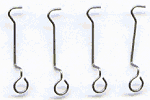 |
This
connecting arm will also ensure the first road wheel takes advantage of the
spring on the idler axle to be held in place.
The road wheels themselves have very well defined hub and bolt detail while
the drive sprocket has the lightening holes in the outer rim section and the
two guide rings in the centre of the sprocket, all wheels are also held in place
by poly caps as is normal for Tamiya.
Shock absorbers are on the
two front and rear axles as well as the travel stops on the lower hull, in all
a very comprehensive suspension assembly.
The rear final drive housings have nice bolt detail as well as the large support
flanges between the bottom hull and the drive housings.
The rear hull plate has nice weld seems and a hollow exhaust outlet for good
definition plus the lights, telephone box and tow cable fitted.
Hull
Top:
As mentioned the cast effect
on the hull is very nicely done and the hull has separate hull hatches and engine
bay doors, I think the doors aren’t separate with adding an engine in
mind but more to achieve good definition for the louvers on the doors, but of
course it makes adding an engine easy (do I hear resin makers working on this
right now?).
The hinge detail on the driver’s and co-driver’s hatches is well
defined with separate outer sections and hinge mechanism and the hatches feature
interior detail. The hull machine gun is also a separate part that fits into
the hull opening from the inside.
The upper hull also has
the full fenders included which make for a large moulding. It should be noted
that the kit doesn’t include the fender bracing turnbuckles on the front
and rear fenders as seen on many M26s. This is correct for the initial series
T26E3s shipped to the ETO in early 1945 (notable those taking part in Operation
Zebra didn’t have these turnbuckles fitted), but were fitted to later
vehicles along with designation change to M26.
If modelling a later WWII M26 or one from Korea these turnbuckles would have
to be added from scratch. It would have been nice to see these included especially
as one of the marking options is for a Korean vehicle.
The fender storage boxes and supports are all separate as are the lights and guards as you would expect. The periscope guards on the hatches are also separate pieces which is nice to see.
The
Turret:
This again features nice
cast texture with casting numbers on the rear bustle; all hatches are separate
with interior detail while the gun mount is held in place with large poly caps
to allow movement. The large mantlet also has good cast texture but no casting
numbers as there should be, with the barrel being the usual two halves with
a separate large muzzle brake also in two pieces.
Many small fittings are provided for the turret exterior including the spare
track mounts and large storage box on the right side.
The width of the turret bustle from just behind the crew hatches arrears to
be slightly too narrow but I don’t think it’s something that most
would notice or probably even worry about?
Two crew members are included, a three quarter figure tank commander and half figure loader designed to fit into the open turret hatches, the uniform detail is quite good on these and a huge improvement on kit figure from the past.
The
Tracks:
These are the T81 type supplied
as continuos lengths but are quite flexible and feature adequate details inside
and out, although the guide pins are solid instead of having the centre cut-out,
something that would almost be impossible to include in this medium.

Decals:
The decals feature a good
selection of vehicle markings, data stencils and a few data stencils for 2 ‘K’
ration packs. The decals themselves have the usual Tamiya thick carrier
film we have come to know and love?
Markings provided are for four vehicles:
A: Company B, 1st Tank Battalion, USMC, Inchon Korea, September 1950
B: No.9, Tank Company A, 18th Tank Battalion, 8th Armored Div, Czech
Slovakia, 1945
C: No.10, Tank Company E, 76th Armor Rgt, 2nd Armored Div, Germany 1945
D: No.5, 2nd Platoon, Tank Company F, 33 nd Armored Reg, 3rd Armored
Div, Elsdorf Germany, February 1945

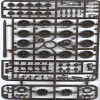
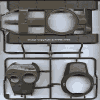
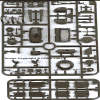


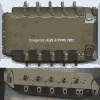
Conclusion:
Another nice kit from Tamiya,
the workable suspension will be a talking point but is it worth the effort?
As most modellers will not be playing with the finished kit but end up putting
it in a static setting, either a diorama, sitting on a small base or just the
table I’m not sure? The same result could be achieved just be giving the
axles separate as Dragon did, but on the positive it will allow you to
position the vehicle on uneven ground without having to work out the axles positions
and glue in place before the kit is finished, so I guess it’s up to the
individual to decide.
Overall it is another excellent offering from Tamiya with many fine details
and the usual ease of assembly and adds to the ever growing ranks of allied
vehicles.
Dragon
v Tamiya:
It is inevitable that comparisons
will be made between the two kits as they are both of the same T26E3, I have
added here a brief comparison with pics of the
two kits parts side by side.
But I can say that both kits are very good with pluses and minuses in both and
it certainly is not a case of offloading the older kit just because Tamiya
have released one as with some other kits.
| Pershing: A History of the Medium Tank T20 Series Presidio Press Richard P. Hunnicutt  |
The M26 Pershing
and Variants T26E3/M26, M26A1, M45, M46/M46A1 Schiffer Military History Book Troy D. Thiel ISBN 0-7643-1544-7  |
| M26 Pershing Medium Tank Museum Ordnance Special Number 3 G.Ronald Lehman Darlington Productions, Inc.  |
M26/M46 Pershing Tank 1943-1953 Osprey New Vanguard 35 Steven J. Zaloga ISBN 1 84176 202 4  |
| Allied-Axis The Photo Journal of the Second World War No.7 Ampersand Publishing.  |
Pershing/Patton in Action Squadron/Signal books #2040 Jim Mesko and Don Greer. ISBN 0-89747-442-2  |
On
the Web:
AFV
Interiors
(excellent details in the Archives)
IPMS London (A nice walkaround in the Reference section)
TM 9-735 (M26 Manual
on-line)
Patton-Mania.com
(A new site worth watching, includes a section on the M26)
Page created 3 July 2002